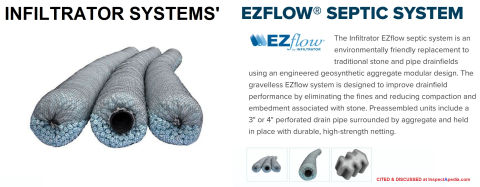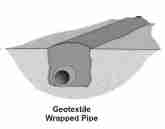 Gravelless Septic Systems - Geotextile-Wrapped Designs
Gravelless Septic Systems - Geotextile-Wrapped Designs
- POST a QUESTION or COMMENT about the design, installation, use, maintenance, & repair of geotextile-wrapped no-rock or gravelless septic systems
Gravelless or "no-rock" septic system designs:
This article explains design of gravelless or "no gravel" or "no rock" septic drainfield systems using geotextiles and offering installation specifications. Drainfields, also called leach fields, absorption beds, soil absorption systems, and leaching beds, perform the functions of septic effluent treatment and disposal in onsite wastewater treatment systems, conventionally called "septic systems".
InspectAPedia tolerates no conflicts of interest. We have no relationship with advertisers, products, or services discussed at this website.
- Daniel Friedman, Publisher/Editor/Author - See WHO ARE WE?
Use of Geotextile-Wrapped Perforated Pipe for Onsite Wastewater Treatment and Disposal
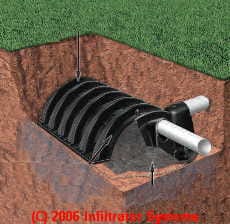
1. Gravelless Systems - Gravelless Septic Absorption Systems
There are three typical gravel-less effluent disposal systems in current use and shown in the US EPA sketches below (originally from NSFC) and I describe a fourth variation which is provided by some manufacturers:
This article describes the second type - Geotextile-wrapped designs.
Gravelless septic systems or "no gravel" septic system trenches use plastic or other prefabricated wastewater distribution systems which are buried in soil without the use of surrounding gravel.
Typical gravelless septic systems use a plastic chamber, a geotextile-wrapped pipe, or a polystyrene-wrapped pipe to distribute effluent into the soil.
The necessary soil absorption area is provided by the perforated surface of the gravelless septic system components (or by soil at the bottom of a chamber) themselves rather than by the gravel and trench walls of a conventional septic drainfield.
These systems can provide an acceptable effluent disposal system for sites with limited space for a drainfield or where gravel is not available or is quite expensive.
2. Geotextile-wrapped perforated pipe buried in an earthen trench. In this type of system, a large diameter corrugated plastic pipe (eight inches or greater in diameter) surrounded by a hydrophilic geotextile is installed in an excavated trench using only the original soil as backfill.
Other systems utilizing products such as galleys, flow diffusers or leaching chambers can be installed without aggregate backfill.
One linear foot of these products shall be equivalent to one linear foot of conventional (24 inch wide) absorption trench.(1) For an example of this geotextile-wrapped pipe approach to wastewater disposal using 8" or 10" diameter piping, see Crumpler Plastic Pipe's "No-Rock TM Septic-Leachate drainpipe systems" listed at Product Sources below.
CPP informs us that because the square foot equivalent leaching area when this system is used is not a foot-for-foot ratio based on a 36" trench, the 8" & 10" CPP Filter Wrapped systems are typically longer than the traditional septic drainfield trenches.
Although the individual line length may be longer, the CPP system may actually require less total square footage of lot space if the on-center line spacing is controlled by the excavated trench width treatment plume & not an "arbitrary CODE stipulation".
According to CPP, this added length achieves superior distribution to the trench sidewall where the bulk of the septic liquid enters the soil for treatment. [One reason for wider trench on-center spacing advanced by some health departments is to assure that the site affords space for future trench line replacement .--DF].
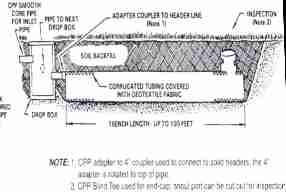 Most sanitary or health department codes size 8" diameter Geotextile-Wrapped Perforated Pipe to equal a 2 Foot wide
conventional septic drainfield trench, and similarly size 10" diameter Geotextile-Wrapped Perforated Pipe to be
equal to a 2.5 foot wide conventional drainfield trench.
Most sanitary or health department codes size 8" diameter Geotextile-Wrapped Perforated Pipe to equal a 2 Foot wide
conventional septic drainfield trench, and similarly size 10" diameter Geotextile-Wrapped Perforated Pipe to be
equal to a 2.5 foot wide conventional drainfield trench.
In determining how much leach field area shall be provided when using Geotextile-Wrapped Perforated Pipe, most state codes (where they have them) will require that the cubic footage that would have been required if a conventional 3-foot wide conventional perforated pipe & gravel leach field system had been installed will be used to determine the size 2 Foot or 2.5 foot wide gravelless systems as well.
Thus if 100 feet of a conventional gravel system in 3 Foot wide trenches is required for one bedroom (or 300 Cubic Ft), then 150 feet of 8" Geotextile-Wrapped Perforated Pipe will be required or 120 feet of 10" diameter Geotextile-Wrapped Perforated Pipe.
Sketch of geotextile-wrapped pipe in plan view, courtesy of Crumpler Plastic Pipe - CPP - links below.
For OC (On-Center) spacing of parallel lines treating sewage from a 2 bedroom home, a conventional gravel system of 100 foot length would require 1200 square feet of lot surface area if 3 times the actual 'excavated' trench width is used for OC separation. In comparison, for an 8" Geotextile-Wrapped Perforated Pipe system, which can be placed in a 1.5 Ft(18") wide trench, 1,125 square feet of lot surface area would be required.
For a 10" diameter Geotextile-Wrapped Perforated Pipe, which can be placed in a 1.5 Ft (18") wide trench, 900 square feet of lot space is needed.
If a different or as CPP puts it "arbitrary" OC trench width spacing is mandated (ie: 5 ft or 7 Ft OC required regardless of 'excavated' trench width) by a state code, then the lot surface area calculations will of course be different.
[Thanks again to Crumpler Plastic Pipe, Inc. for this added detail. Links to this company's website and products are provided below.]
What all this means is that for a given building usage and set of soil conditions, whether or not the Geotextile-Wrapped Perforated Pipe system is going to provide the necessary effluent handling capacity in a smaller total square feet
Geotextile-wrapped No-Rock Pipe Installation Details
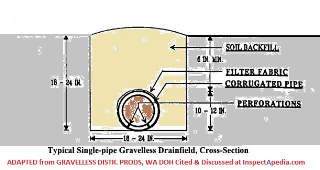 Watch out: The corrugated pipe used for a gravelless or no-rock septic effluent disposal system should comply with ASTM-667.
Watch out: The corrugated pipe used for a gravelless or no-rock septic effluent disposal system should comply with ASTM-667.
Also the installer should be careful to note that the filter wrap is light sensitive, and should not be exposed to sunlight for extended periods of time.
The installer should also take care during installation to avoid tearing of the filter material. The protective plastic wrap that protects the filter should be disposed of offsite. -
l Crumpler cited below.
Consultants or supplies in this field can be listed at our alternative septic designers page at no charge by contacting InspectApedia.com - use the page bottom CONTACT link.
Geotextile-Wrapped No-Rock Septic System Pipe Sources
- See GRAVELLESS NO-ROCK SEPTIC SUPPLIERS Leach Field Septic Systems Products Directory List
- ASTM-F-481 Standard Practice for Installation of Thermoplastic Pipe and Corrugated Pipe in Septic Tank Leach Fields, ASTM, available at https://www.astm.org/Standards/F481.htm
Abstract
This practice describes procedures for handling and installing thermoplastic pipe and corrugated pipe in septic tank leach fields, curtain drains, and from the septic tank to the leach field.
Proper installation ensures that the pipe will satisfactorily convey and distribute partially treated waste water to a leaching field for additional treatment and disposal by soil absorption. The curtain or perimeter drain will function to protect the soil absorption capacity of the leach field.
Pipe should be stored with support from a flat surface to prevent the pipe from developing a permanent set.
Care should be exercised during loading, unloading, and in transit because pipe may be damaged by abrasion and sharp edges. Because thermoplastics are temporarily softened by high temperatures, care should be taken under these conditions to avoid damage during handling operations.
Coiled pipe is not recommended for use in leach fields because it is difficult to install at the proper grade and alignment; it is acceptable with special equipment installation.
Pipe can reach comparatively high temperatures when exposed to the sun and this reduces the pipe stiffness appreciably. Therefore, precautions must be taken to prevent the impact of sharp or heavy objects, the sudden imposition of heavy overburden or excessive pull on such pipe.
The pipe regains full strength and stiffness as the temperature decreases to that of the soil; this will normally require about five minutes.
Care in handling and installation should be exercised under low-temperature conditions to avoid damage. As temperatures decrease, some types of pipe tend to become more brittle and less flexible. - WA DOH, GRAVELLESS DISTRIBUTION PRODUCTS [PDF] (2014) Washington State Department of Health, Northeast Tri County Health District 240 E. Dominion Ave. Colville, WA 99114USA, Tel: (509) 775-3111, retrieved 2019/02/11 original source https://www.netchd.org/fileadmin/user_upload/Environmental%20Health/Onsite%20Sewage/Guidelines_and_Standards/OSS-_Standards_and_Guidance_for_Gravelless_Distribution_Products-_September_2014.pdf
Example product for geotextile-wrapped no-rock septic systems
- CPP’S No-Rock ™ Fabric Wrapped Septic Pipe [PDF] (2019) Crumpler Plastic Pipe, .O. Box 2068, Highway 24 West, Roseboro, NC 28382 USA, Tel: 1-800-334-5071
Email: cppsales@cpp-pipe.com retrieved 2019/02/11 original source: www.cpp-pipe.com/no_rock.html
Website excerpt:
Large diameter CPP Gravelless septic tank trench systems use a filter wrap that allows for the installation of septic treatment pipes without gravel. The advantage in using CPP No-Rock is evident in areas where there is a shortage of inexpensive quality rock or where the shape and topography of a lot hinder the access of heavy construction equipment.
Less equipment use means trees can be saved, less lot grading is needed, and thus fuel and labor are saved.
ASTM-F-481 septic installation specification should be reviewed prior to installation.
Some states allow Gravelless large diameter systems to be substituted for conventional systems in Any Soil Type deemed acceptable for a conventional system.
Others do not. One should check with local septic inspectors for locally approved soils. Iron Ocre proned organic soils and fine silt soils are examples of unsuitable soil types for fabric wrapped pipes.
CPP’S No-Rock™ septic systems maybe substituted for any conventional 4” pipe gravel trench system utilizing distribution devices, serial distribution, hillside or stepdowns.
However, it should not be substituted for bed systems or installed in fill material. It should also be limited to domestic sewage, and not used where there will be large amounts of grease or oil such as in restaurants unless designed by an engineer.
The 8” size pipe will equal to 2-foot wide conventional trench; and the 10” size will equal a 2.5-foot wide trench. To determine the required linear footage of either pipe size, first determine the square footage by dividing the design sewage flow by the appropriate soil’s long term application rate.
Then divide this total square footage area figure by either 2 feet (for 8”) or 2.5 feet (for 10”) to establish the linear footage amount. ... on center (oc) spacing is determined by actual trench width. - retrieved 2020/05/09 original source: Crumpler Plastic Pipe, http://www.cpp-pipe.com/no_rock.html - Hancor, INSTALLATION GUIDELINES for Gravelless Pipe
For Septic Tank Leach Fields [PDF] (2005) Innovative Drainage an Water Conservation Solutions, Installation Guidelines for Gravelless Pipe
For Septic Tank Leach Fields, retrieved 2020/05/09
- Infiltrator Systems also provides their EZFLOW filter-fabric-wrapped round bundles for effluent distribution, in a range of product sizes and capacities. [shown above]
Tel: 800-718-2754 Old Saybrook CT USA. Website: http://www.infiltratorsystems.com/ or 4 Business Park Road P.O. Box 768 Old Saybrook, CT 06475
860-577-7000 - 1-800-221-4436
Website excerpt:
The Infiltrator EZflow septic system is an environmentally friendly replacement to traditional stone and pipe drainfields using an engineered geosynthetic aggregate modular design.
The gravelless EZflow system is designed to improve drainfield performance by eliminating the fines and reducing compaction and embedment associated with stone.
Preassembled units include a 3" or 4" perforated drain pipe surrounded by aggregate and held in place with durable, high-strength netting. - US EPA, SEPTIC TANK LEACHING CHAMBER [PDF] (2000) United States
Environmental Protection
Agency, Office of Water,
Washington, D.C. EPA 832-F-00-044
Excerpt: A typical leaching chamber consists of several highdensity polyethylene arch-shaped, injection-molded chamber segments.
A typical chamber has an average inside width of 51 to 102 centimeters (20 to 40 inches) and an overall length of 1.8 to 2.4 meters (6 to 8 feet). The chamber segments are usually one-foot high, with Source: Infiltrator Systems Inc., 2000. FIGURE 1 LEACHING CHAMBER wide slotted sidewalls, which are usually 20 degrees toward the chamber center or away from the trench sidewall.
Each chamber segment is designed to mechanically interlock with the downstream chamber segment, forming a complete drainfield trench that consists of an inlet plate with a splash plate below the inlet on the trench bottom, and a solid-end plate at the distal end of the chamber drainfield line.
...
Continue reading at GRAVELLESS SEPTIC CHAMBER SYSTEMS or select a topic from the closely-related articles below, or see the complete ARTICLE INDEX.
Or see these
Recommended Articles
Suggested citation for this web page
NO-ROCK SEPTIC GEOTEXTILE-WRAPPED PIPE at InspectApedia.com - online encyclopedia of building & environmental inspection, testing, diagnosis, repair, & problem prevention advice.
Or see this
INDEX to RELATED ARTICLES: ARTICLE INDEX to SEPTIC SYSTEMS
Or use the SEARCH BOX found below to Ask a Question or Search InspectApedia
Ask a Question or Search InspectApedia
Questions & answers or comments about the design, installation, use, maintenance, & repair of geotextile-wrapped no-rock or gravelless septic systems .
Try the search box just below, or if you prefer, post a question or comment in the Comments box below and we will respond promptly.
Search the InspectApedia website
Note: appearance of your Comment below may be delayed: if your comment contains an image, photograph, web link, or text that looks to the software as if it might be a web link, your posting will appear after it has been approved by a moderator. Apologies for the delay.
Only one image can be added per comment but you can post as many comments, and therefore images, as you like.
You will not receive a notification when a response to your question has been posted.
Please bookmark this page to make it easy for you to check back for our response.
IF above you see "Comment Form is loading comments..." then COMMENT BOX - countable.ca / bawkbox.com IS NOT WORKING.
In any case you are welcome to send an email directly to us at InspectApedia.com at editor@inspectApedia.com
We'll reply to you directly. Please help us help you by noting, in your email, the URL of the InspectApedia page where you wanted to comment.
Citations & References
In addition to any citations in the article above, a full list is available on request.
- New York State Department of Health, APPENDIX 75-A WASTEWATER TREATMENT STANDARDS - INDIVIDUAL HOUSEHOLD SYSTEMS , [PDF] New York State Department of Health, 3 February 2010, retrieved 3/1/2010, original source: https://www.health.ny.gov/regulations/nycrr/title_10/part_75/appendix_75-a.htm
- Crumpler Plastic Pipe, Inc. Crumpler provides fabric-wrapped drainage piping 800-334-5071 Roseboro NC USA - "No-Rock TM Septic-Leachate drainpipe systems" are available in 8" and 10" systems.
- Jeff Pildis, Technical Service & Support, Infiltrator Systems, Inc. 800-718-2754
- In addition to citations & references found in this article, see the research citations given at the end of the related articles found at our suggested
CONTINUE READING or RECOMMENDED ARTICLES.
- Carson, Dunlop & Associates Ltd., 120 Carlton Street Suite 407, Toronto ON M5A 4K2. Tel: (416) 964-9415 1-800-268-7070 Email: info@carsondunlop.com. Alan Carson is a past president of ASHI, the American Society of Home Inspectors.
Thanks to Alan Carson and Bob Dunlop, for permission for InspectAPedia to use text excerpts from The HOME REFERENCE BOOK - the Encyclopedia of Homes and to use illustrations from The ILLUSTRATED HOME .
Carson Dunlop Associates provides extensive home inspection education and report writing material. In gratitude we provide links to tsome Carson Dunlop Associates products and services.


